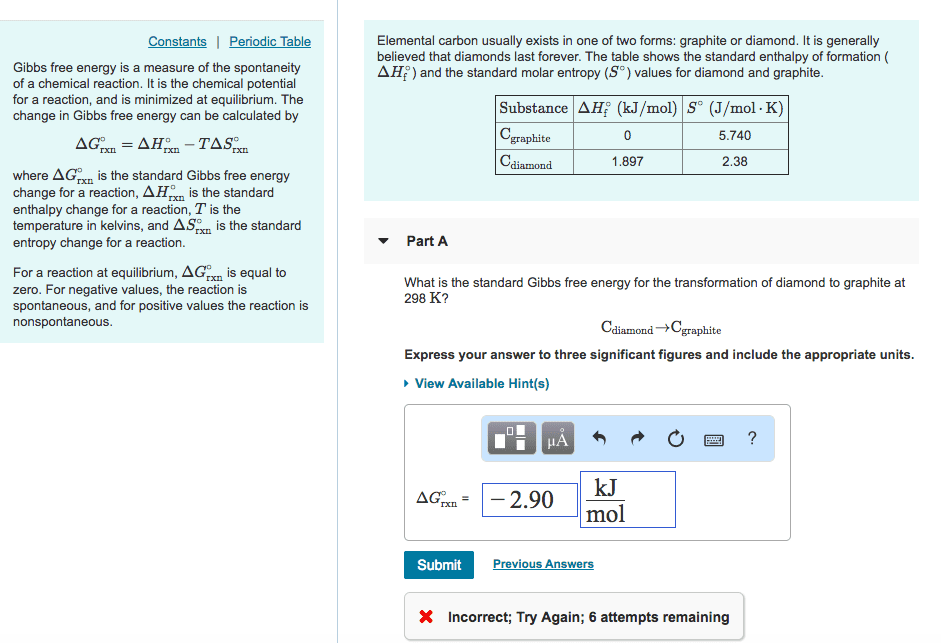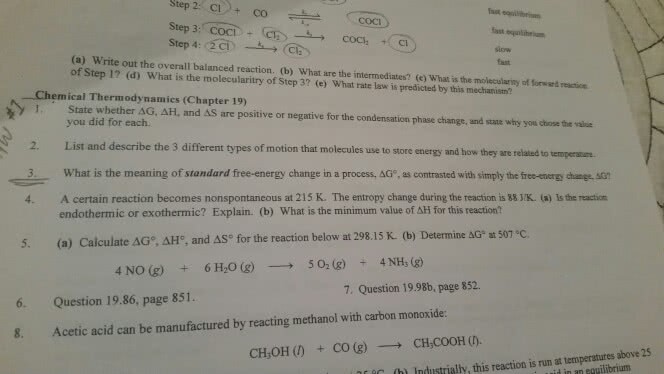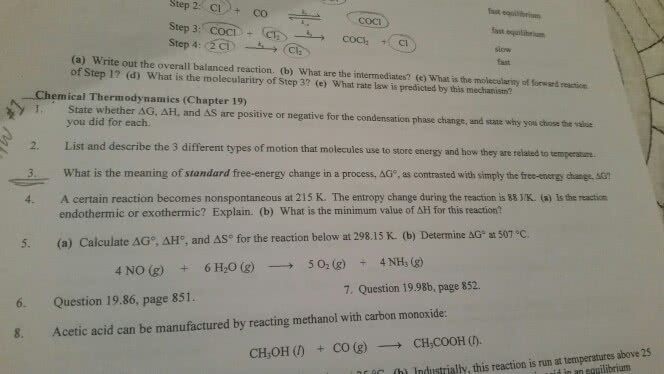01:160:162 Lecture Notes - Lecture 19: Chemical Thermodynamics, Boltzmann Constant, Endothermic Process

Chapter 19: Free Energy and Thermodynamics
19.1 Energy Spreads Out
19.2 Spontaneous and Nonspontaneous Processes
19.3: Entropy and the Second Law of Thermodynamics
Entropy
The second law of thermodynamics
Macrostates and Microstates
The Units of Entropy
19.4: Predicting Entropy and Entropy Changes for Chemical Reactions
The Entropy Change Associated with a Change in State
The Entropy Change Associated with a Chemical Reaction ( S°rxn)△
Standard Molar Entropies (S°) and the Third Law of Thermodynamics
Calculating the Standard Entropy Change ( S°rxn) for a Reaction△
19.5: Heat Transfer and Entropy Changes of the Surroundings
The Temperature Dependence of S(surr)△
Quantifying Entropy Changes in the Surroundings
19.6: Gibbs Free Energy
The effect of H, S, and T on spontaneity△ △
Case 1: H Negative, S positive△ △
Case 2: H Positive, S negative△ △
Case 3: H negative, S negative△ △
Case 4: H positive, S positive△ △
19.7 Free Energy Changes in Chemical Reactions Calculating G°rxn△
Calculating Standard Free Energy Changes with G°rxn= H°rxn-T S°rxn△ △ △
Calculating G°rxn with tabulated values of free energies of formation△
Calculating G°rxn for a stepwise reaction from the changes in free energy for each of the steps△
Making a Nonspontaneous Process Spontaneous
Why Free Energy is “Free”
19.8: Free Energy Changes for Nonstandard States: The relationship between G°rxn and Grxn△ △
Standard conditions (H2O(l) → H2O(g), Q=PH2O)
Equilibrium conditions (H2O(l) → H2O(g), Q=PH2O)
Other Nonstandard Conditions (H2O(l) → H2O(g), Q=PH2O)
19.9: Free Energy and Equilibrium: Relating G°rxn to the Equilibrium Constant (K)△
Temperature dependence of Equilibrium Constant
find more resources at oneclass.com
find more resources at oneclass.com

I. 19.1 Energy Spreads Out
A. Second Law of Thermodynamics : Energy spreads out (or disperses) from a more
concentrated to a less concentrated form. Fundamental to all changes.
A.1. E.g. hot cup of coffee cools down. The thermal energy concentrated in
the hot coffee spreads out into the surroundings. The coffee cools down but the
surrounds warm up.
A.2. E.g. letting go of a book and watching it fall to the floor. As it falls, the
potential energy (due to gravity) that was concentrated in the book gets converted
into kinetic energy (energy due to motion) and dissipates s thermal energy when
the book hits the floor.
II. 19.2 Spontaneous and Nonspontaneous Processes
A. The study of thermodynamics helps us to understand and predict whether a particular
process will spontaneously occur
A.1. Spontaneous process- one that occurs without ongoing outside
intervention
A.1.a) Do not confuse spontaneity with speed
(A.1.a.1) Spontaneity- direction in which and the extent to which a
chemical reaction proceeds. Studied in chemical
thermodynamics.
(A.1.a.2) Speed- how fast it takes place. Studied in kinetics.
(A.1.a.3) Can be spontaneous but kinetically slow
A.1.b) Rate can be increased by using a catalyst but cannot make a
nonspontaneous process spontaneous. Only affect the rate, not
spontaneity.
A.1.c) Nonspontaneous process is not impossible.
(A.1.c.1) Coupling it to another process that is spontaneous or by
supplying energy from an external source.
III. 19.3: Entropy and the Second Law of Thermodynamics
A. The way to judge spontaneity of a chemical process is to examine the change in enthalpy
for the process
A.1. Mechanical system proceeds in the direction of lowest potential energy
A.1.a) Chemical system might proceed in the direction of lowest
enthalpy
(A.1.a.1) All exothermic reactions would be spontaneous and all
endothermic reactions are not
(A.1.a.1.a) HOWEVER most exothermic are spontaneous
but some are endothermic
(A.1.a.1.a.i) E.g. water spilled on the floor spontaneously
evaporates although it is endothermic
find more resources at oneclass.com
find more resources at oneclass.com

(A.1.a.1.a.i.a) Evaporation: thermal
energy of the water molecules spread
out from a smaller volume into a much
larger volume (gas has more volume
than liquid, the molecules have much
more empty space between them)
(A.1.a.1.a.i.b) Entropy increases
(spreading out of energy)
B. Entropy
B.1. Criterion for spontaneity in all systems. Abbreviated by the symbol S
B.2. Entropy (S) is a thermodynamic function that increases with the number
of energetically equivalent ways to arrange the components of a system to
achieve a particular state
B.3.
B.3.a) K is the Boltzmann constant - gas constant divided by
Avogadro’s number R/N(A)= 1.38*10^-23 J/K
B.3.b) W is the number of energetically equivalent ways to arrange the
components of the system
(B.3.b.1) Unitless
B.3.c) S is joules per kelvin (J/K)
B.3.d) As W increases, S increases
B.4. Imagine a system of particles colliding with each other and the walls of
the container
B.4.a) A given set of conditions (P,V, and T) defines the macrostate of
the system.
(B.4.a.1) Overall energy is constant as long as the conditions are
constant
(B.4.a.2) Exact distribution of energy is not constant!
(B.4.a.2.a) Microstate- exact internal energy distribution
among the particles at any one instant. Snapshot.
Generally different from one moment to the next as the
energy of the system constantly redistributes itself
among the particles of the system.
(B.4.a.2.a.i) Macrostate remains constant
(B.4.a.2.a.ii) W is the number of possible microstates that can
result in a given macrostate
(B.4.a.2.a.ii.a) E.g. System A and B
with total E of 4J
(B.4.a.2.a.ii.a.i) A has one energy level. One
possible microstate (red and
blue occupy the same) (w=1)
find more resources at oneclass.com
find more resources at oneclass.com
Document Summary
19. 3: entropy and the second law of thermodynamics. 19. 4: predicting entropy and entropy changes for chemical reactions. The entropy change associated with a change in state. The entropy change associated with a chemical reaction ( s rxn) Standard molar entropies (s ) and the third law of thermodynamics. Calculating the standard entropy change ( s rxn) for a reaction. 19. 5: heat transfer and entropy changes of the surroundings. The effect of h, s, and t on spontaneity. 19. 7 free energy changes in chemical reactions calculating g rxn. Calculating standard free energy changes with g rxn= h rxn-t s rxn. Calculating g rxn with tabulated values of free energies of formation. Calculating g rxn for a stepwise reaction from the changes in free energy for each of the steps. 19. 8: free energy changes for nonstandard states: the relationship between g rxn and grxn. 19. 9: free energy and equilibrium: relating g rxn to the equilibrium constant (k)




